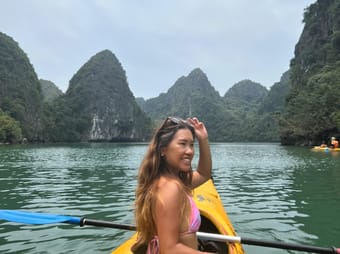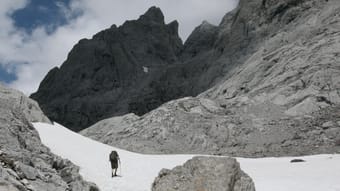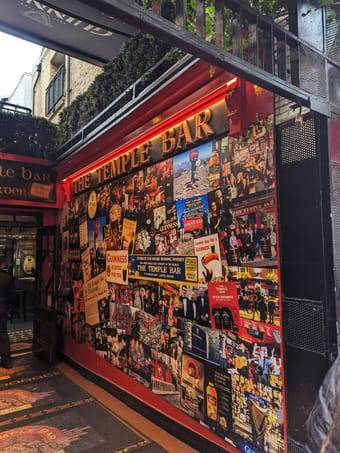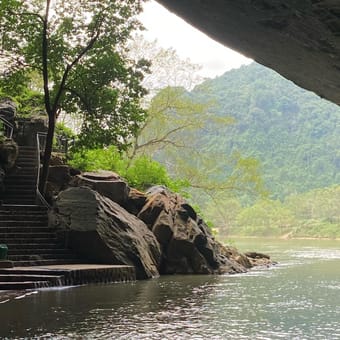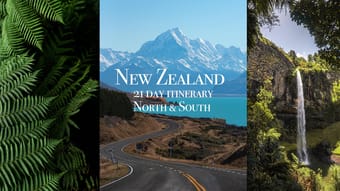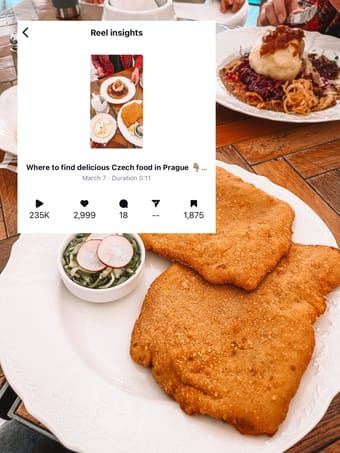Results for The Lime
Limerick is a town oozing with cultural history, much of which was documented by world-famous author, Frank McCourt. From hiking on the seaside to live music at the Irish pub, there are an abundance of things to do in Limerick that’ll keep your wanderlust soul [and stomach] fed.
Couples • Groups • History • Adventure • Architecture • Art • Foodie • People & Culture • Shopping • Nature • Photography • Relaxation • Coffee • Romantic
Free
8
Welcome to London!
Travelling with a kid can be tricky, but I'm here to help! I have created a one-week guide for my brother and his family, and I hope you will find it useful as well.
But in any case, this itinerary is ideal for couples and families traveling without children.
💡This guide is divided into sections by neighbourhood to showcase some of my favourite full-day walks around the city.
Each walk is a delightful adventure, carefully curated to include at least one stop your child will love. Whether it's a museum, zoo, hot chocolate cafe, or a park, there's something for everyone to enjoy.
🏠 If you need my help finding apartments based on your requirements, write to me. I have rented more than 70 apartments on Airbnb and have recommended a huge number to my friends.
🤹At the end of the itinerary you can find extra entertainment for your children.
❌My restaurant recommendations are not strictly created for families with children, as all have their own preferences regarding food.
🚲This guide focuses on walking routes, but you can also use rental bikes (Santander, Lime, or Voi), buses, or the underground (tube) to get around.
You can pay for public transport with a contactless card or phone or ride-sharing services like Uber or taxis.
50+ • Backpacker • Car-free • Couples • Groups • Family • Digital Nomads • LGBTQ+ • Female Solo • Adventure • History • Foodie • Romantic • Relaxation • Photography • Slow Travel • People & Culture
Free
2
Embark on a captivating journey through Vietnam's treasures with this guide.
• In Hanoi, savor diverse street food, and explore the Old Quarter's charm.
• Venture to Ninh Binh, where limestone karsts and ancient temples create a breathtaking landscape.
• Then, set sail for Cat Ba Island, a haven of lush landscapes and pristine beaches.
What’s in the guide?
🛵 Attractions. 👄 Local Food. 🌏 Stay.
*This guide is constantly being updated.
**Appreciate tips (at the bottom of the page) if you find this helpful!
Free
4
Seven-day trek based in refugios.
INTRODUCTION
The Picos de Europa is a region of limestone peaks reaching over 2500 metres above sea level; the highest being Torre de Cerredo at 2650 metres. The route described here is one that I hiked alone in early summer. The best time to tackle the route is between June and September. There is more likely to be snow on the high passes in early June but they are usually not to difficult to negotiate.
The Picos de Europa is not as well known as the Pyrenees or Alps and as such the hiker traffic is less and the tourist infrastructure is less developed. This makes the area feel less spoilt but it can also make it a more challenging area to explore with fewer trails and little to no signposting. Always take a map with you: the Editorial Alpina 1:25,000 maps are the best. I took these and also used the outdooractive app and downloaded the relevant map tiles. This is useful for pinpointing where you are, in what can be confusing terrain. I was lucky to have clear weather for my entire trek but I would imagine that it's pretty difficult to navigate when the cloud is down on the mountains so take a compass too.
You can stay in refugios every night on this hike and wild camping is permitted above 1500m; details below.
I can't recommend the Picos de Europa as a hiking destination enough. The mountains are magnificent but there are also beautiful extensive woodlands at lower altitudes, as well as meadows full of wildflowers and butterflies. The juxtaposition between the stark limestone peaks and the gentle greenery of the valleys is beguiling.
DISCLAIMER: Please note that hiking in the Picos de Europa is not risk free. It is a very challenging area in which to hike. I accept no responsibility for any accidents you may experience while hiking this route. You are responsible for your own safety. Some of the dangers and difficulties are listed a little further down this guide.
HOW BUSY?
Unlike some of the more well know hikes around Europe this trail is less well trodden and as such the trail can be quite hard to follow at times, and at other times there is no trail! Despite this, refugios, being small, fill up fast (see below).
REFUGIOS
The hike is made easier if you stay in the staffed refugios where you can recharge your metaphorical batteries. Accommodation at these mountain huts is in communal dormitories and you will need to bring your own sleeping bag. It's best to book ahead as they are often full throughout the summer. Prices are around the €12-17 mark and they also do affordable meals (breakfast, picnic lunch and dinner).
There is also a handful of unstaffed, very basic mountain shelters with no services and no beds but these can be a good option in an emergency. Most of the refugios only accept cash so be sure to take plenty with you before you set off as there are no ATMs! All the refugios on the route are listed in the route description below with website links.
WILD CAMPING
Camping is only permitted at 1500m above sea level or higher. There is not much water anywhere above this altitude so be sure to fill up when you get the chance (at refugios) before camping in a remote spot.
POSADA DE VALDEON
This beautiful village tucked in the valley between the Macizo Central and Macizo Occidental is a lovely place to wander for a few hours. At the centre of the village there are a number of restaurants and bars and a small square with a water fountain. If you need somewhere to stay before or after the trek you'll find hotels, guest houses and a youth hostel. There is a hotel recommendation and link in the route description.
In the centre of the village is a pharmacy should you need any blister plasters! And on the road to the west of the village is the National Park office where you can find information about hiking and anything else to do with the national park.
GETTING THERE
From the UK there are Ryanair flights to Oviedo (Asturias airport) from London Stansted. A bit further afield you can get flights to Bilbao and Santander from the UK and the rest of Europe. Getting from the airport is a little complicated but there are buses to Posada de Valdeón from Oviedo changing in Cangas de Onis. The journey takes about 4.5hrs. There are also buses from Santander and Bilbao changing in Llanes and Riaño with the journey taking around 15hrs from Bilbao.
An easier but more expensive option is to get a taxi. You could also hire a car but of course you will have to leave the car sitting idle in Posada de Valdeón while you do the hike.
FLORA & FAUNA
This area of northern Spain is fantastic for wildlife. At lower elevations the beech and sessile oak woodland stretches for miles over rolling hills. This is part of the boreal forest that once would have covered much of Europe and is home to roe deer, wild boar, red squirrels, pine martens and brown bears.
In the skies you have a good chance of seeing griffon vultures, golden, booted and short-toed eagles, black kites and peregrines. Of the smaller passerine species the Picos are home to red-backed shrikes, black redstarts, spotted flycatchers and black woodpeckers.
But it's the wildflowers in the meadows and on the woodland edges that are the real joy and most easily appreciated. Vetches, cinquefoils and orchids create a colourful patchwork of colours with butterflies bringing the whole scene to life. Look out for swallowtails, fritillaries and hairstreaks.
NAVIGATION
Navigation is difficult as the terrain can be confusing and in many places there is no trail whatsoever. Take a map (1:25K Editiorial Alpina maps are the best), compass and GPS and know how to use them. It's also a good idea to download the map on a relevant map app. I used the outdooractive app but others are available.
WEATHER
Thunderstorms are common, usually in the afternoon and these can be particularly dangerous high up in the mountains. It's best to hike early and get to a refugio by lunchtime if there are afternoon thunderstorms in the forecast. The weather in this part of Spain is very changeable as it has a maritime climate. Rain and thick fog are possible but equally long periods of warm sunshine are not unusual. The best advice I can offer is to be prepared for anything. Pack suncream and a sunhat but don't forget your waterproofs either.
FALLING ROCKS
Rock falls are not unusual as chamois and other hikers can dislodge rocks above you. Getting caught in a rockfall is not so common but not impossible. Be aware and if you see rocks heading your way, and cannot find cover, crouch down on the floor and pull your rucksack over your head and back.
DRINKING WATER
There is very little running water as these mountains are mostly comprised of permeable limestone. You will need to take plenty of water with you each day (I packed three litres every day and usually drank it all). You can fill up at the refugios and there are a few fountains / fuentes although most of the ones I saw marked on the Editorial Alpina map were dry when I found them.
THE SUN
Sunburn and sunstroke are both real dangers and there is little shade. Keep hydrated and wear a sun hat that covers your neck.
TERRAIN
In some places you need to scramble up steep rocky sections. You will need to have experience in this kind of terrain and have a head for heights! The terrain is very rocky and uneven at higher altitudes so you will need strong, sturdy footwear. Trekking poles are also invaluable in providing support and helping you across and up awkward sections. There is also a lot of steep ascent and descent on this route so you will need to be reasonably fit.
DANGEROUS ANIMALS
On many parts of the trail you will encounter cows. In my experience they are very docile and used to trekkers so they shouldn't be of any concern. You may also find flocks of sheep and while these aren't dangerous they are often accompanied by shepherd dogs which have been trained to keep intruders away from the flock. They can be quite intimidating when they start barking at you. If you see sheep ahead it is best to give them a wide berth, even if this means veering away from the trail for a while. If you walk directly towards or through a flock of sheep you risk agitating the shepherd dogs.
Bears are not common in the Picos de Europa but there are bears in other parts of the Cantabrian Mountains, notably Somiedo National Park, not far to the west, and there is always the possibility of seeing an itinerant bear wandering through the Picos. Eurasian brown bears are not as big nor aggressive as the grizzly bears of North America so you shouldn't worry too much about an encounter. It's extremely unlikely you will see one so if you do, consider yourself very lucky.
Wild boar are common in the woodlands at lower altitudes. They are not as aggressive as some people will tell you and tend to be nocturnal. I did see some in the daytime near Vegabaño. As soon as they saw me they ran away, crashing through the undergrowth. As with any large animal it's best to simply give them plenty of space to move away from you.
I hope none of this advice puts you off hiking in the Picos de Europa. Yes, it's a challenging mountain area but the rewards for hiking here are great. Enjoy the hike!
Adventure • Nature • Slow Travel • Sustainable/Eco • Mountain • Camping
$12.00
3
Ao Nang is a popular tourist destination in Krabi, Thailand. It's well-known for its limestone cliffs and day trips to nearby islands & Railay Beach. It also has some great diving spots nearby.
I spent two weeks here in August 2022 and despite its small size there is plenty to see & do here. Here are my top finds in Ao Nang, Krabi.
Adventure • Budget • Luxury • Foodie • Nature • Coffee • Beach • Mountain
Free
3
I'm Maeve and I'm 50% Irish (hence the Gaelic name haha). I have visited Ireland at least once a year of my 26 years and to no surprise, it's my absolute favorite place on earth!
My family is primarily from the Shannon and South-East regions of Ireland. My mom and her three brothers were raised in Limerick, my granny was born and raised in Limerick City, and my grandad was born and raised in Cahir, Co. Tipperary. Like many Irish families, we have relatives spread out across the country too.
I know Ireland pretty well for never having actually lived in the country long-term. I grew up spending 8-weeks of my summer in Spanish Point Co. Clare with a bunch of my cousins---just as my mom and granny did when they were younger. When the weather was great we played in the grass, swam in the sea, milked cows, rode horses, and just lived outside all day long. But there were weeks when it felt like the rain never stopped and I can guarantee that 6+ stir-crazy kids were a nightmare to take care. As a result, our parents would take turns going away on overnights or mini staycations within Ireland.
Ireland is majority lush, green, rolling hills and winding country lanes. There is so much to see and do. However, just because you'll likely spend your days in your wellies trekking through the countryside, there is NO need to forfeit the finer things in life when it comes to your accommodation. Here's a guide to 10 luxurious hotels across Ireland perfect for a couple's getaway. The majority of places my family or I have visited ourselves and the others are on my travel wishlist.
As always, I'm happy to help you plan a custom itinerary for your trip to Ireland! Just reach out to me directly (:
Couples • Luxury • Romantic • Relaxation • Foodie • History • Art • Architecture • Wellness • Slow Travel • Photography
Free
2
Surya Sridhar / @peopleplacespalates
Guide to Alberobello in Puglia 🇮🇹 : A charming "Trulli" Town in Italy
Let me show you what to eat, see and do in the enchanting town of Alberobello, located in the Metropolitan City of Bari, Italy, as well as the most unique "trullo" hotels to stay in!
This unique destination is filled with "trulli", conical shaped limestone houses which are scattered throughout the Itrian Valley. Originally used as temporary field sheds by farmers, they were ingeniously designed for easy dismantling to evade tax officers! Interesting eh?
In this guide I will provide you:
- a self guided walking tour of all the stops (including the locations on Google Maps) that you can't miss out on!
- which "Trullo" accommodations I recommend you to stay at if you plan to spend a night or two!
Female Solo • Backpacker • Couples • Digital Nomads • Groups • Family • Road Trip • Budget • Foodie • Architecture • People & Culture • History • Outdoors • Relaxation • Slow Travel • Wellness
$5.00
1
Work brought me to Ireland for a year in 2022. During my time in Limerick, Ireland’s third-largest city, I got to know one of the country´s greatest joys: savoring a good drink! 🍺
From enjoying a good pint to chatting with friendly locals, I really got into the pub scene and soak up the true Irish way of life. ☘
This guide details every Dublin pub I visited during my visits to the capital city, so you can dive right into the best spots.
Get ready to explore Dublin’s pub scene, a true celebration of good times and great company! Dublin’s pubs are the heart and soul of the city.
Cozy corners with crackling fires, lively music sessions with a few dance steps🎻, and a bar staff that feels like instant friends. Dublin’s pubs offer a good time and authentic Irish spirit. 🥂
In this guide you’ll also discover the must-try drinks in Ireland. Just remember, trying to drink like the Irish might not end well. Leave that to the locals!🍻
Don´t forget to save this guide for your future travels to Ireland.💌
Cheers to a night of fun, laughter, and unforgettable memories!
Backpacker • Couples • Groups • Adventure • People & Culture • History
Free
1
Welcome to Railay Beach, a slice of paradise where limestone cliffs meet the embrace of the Andaman Sea. As a resident of this enchanting haven for 1.5 years, I've come to cherish the serene beauty and vibrant energy that define this coastal gem. From the moment you set foot on Railay's shores, you'll be captivated by the sheer majesty of its towering cliffs and the gentle lull of the ocean waves, inviting you to immerse yourself in its tranquil embrace.
It's the perfect balance between adventure and relaxation. Whether it's scaling the iconic limestone caves and cliffs, diving into the vibrant underwater world, or simply unwinding on the soft sands as the sun dips below the horizon, every day in Railay is a new opportunity for discovery and wonder. So, welcome to my home away from home, where every moment is infused with the magic of coastal living and the promise of unforgettable experiences.
Railay Beach's ambiance is peppered with Rastafarian influences. It's a delightful fusion of tropical allure and relaxed charm, offering visitors an escape to paradise. I highly recommend spending at least a few nights here on your Thailand trip!
This guide has all the best guides on: how to get there, hotels, things to see, eat, and explore in Railay. This travel guide has been curated by me who has lived in Railay and often returns for visits. Easy to follow Railay specific travel guide with tricks and tips! Many of these things you would not see on a day tour or find on your own and totally need to explore for yourself!
Backpacker • Couples • Female Solo • Vegan • Vegetarian • Plus Size • Gluten-free / Celiac • 50+ • Digital Nomads • Family • Car-free • Groups • LGBTQ+ • Adventure • Budget • Luxury • Relaxation • Slow Travel • Romantic • People & Culture • Photography • Outdoors • Foodie • Coffee • Architecture
$15.00
0
My Curateful Life
11 days jam-packed Greek road trip: delicious food, fascinating history and beautiful scenery.
A perfect balance of adventurous and relaxing, this itinerary has it all. Learn about the ancient greeks, indulge in Greek cuisine, sample and learn about the olive oil culture in rural Greece and absorb the beauty of greek landscapes, all in 11 days and on a budget of £1200 per person (That's everything: flights, accommodation, food and fuel!)
Included:
- Pre-trip information, daily activities, restaurants and hotel options with my HONEST reviews
- Tips and tricks to make this trip as cost effective and easy for you as possible
- Prices so there aren't any surprises when you get there
An overview of the trip:
Days 1-3 Nafplion
Days 4-6 Limeni
Day 5 Kalamata
Days 6-9 Athens
Days 10-11 Santorini
Vegetarian • Vegan • Female Solo • Backpacker • Couples • Van Life • Road Trip • People & Culture • Overlanding • History • Architecture • Adventure • Budget
$9.50
1
Welcome to Barbados! 🇧🇧 I called this beautiful island home for 6 years, and to this day, it remains one of my favorite places on earth. This guide is a culmination of my years living, exploring and immersing myself in the culture of Barbados.
💡Fun fact: unlike its volcanic counterparts, Barbados is a limestone island located at the easternmost point in the Caribbean. Because of this, locals affectionately call it ‘the rock’.
In this guide, you’ll get to know everything you need to immerse yourself in Barbados:
ℹ️ 1. The Essentials: Geography, currency, weather, best times to visit, and useful tips.
✈️ 2. Transportation: Travelling to, from, and around Barbados.
🛏 3. Accommodations: Where to stay.
📍 4. What to See and Do: Things to do in Barbados.
🏝 5. Ocean Escapades: The best beaches and water activities.
🌱 6. Taste of Barbados: Popular food spots and how to eat vegan.
🔭 7. Insider Recommendations: Local tips and hidden gems.
Let this be your go-to resource for making the most of your time in Barbados, ensuring you create memories that will last a lifetime. Let’s dive in!
Vegan • Adventure • History • Relaxation • People & Culture
Free
2
“Isle of spice where everything is nice”
This is a road map of my beautiful country. There’s a bit of something for everyone, whether you’re the traveler that spare no expense or you’re looking for a simple stay that’s not going to break your pocket, I’ve got it all here for you.
Grenada, Carriacou and Petite Martinique is one of the best kept secret in the Caribbean, untouched by the claws of consumerism. It’s a nature lover’s paradise, covered with lush greenery, 50 white sandy beaches, 15 waterfalls and a great culinary experience.
Couples • Groups • 50+ • Nature • Beach • Luxury • Boutique • Budget • Foodie • People & Culture • History • Photography • Roadtrip • Relaxation
Free
2
There are many different ways to see the Emerald Isle from group travel, to train travel, bus travel, to self-drive or chauffer driven.
This itinerary focuses on some areas of the country that are "off the beaten path" and accessible by self-drive or hiring your own private driver.
We highlight some points of interest that are common to the country, but delve into some other spectacular sites, villages and places that don't normally show up on a "typical Irish getaway".
The itinerary is mapped out for a grand tour of the country, going to towns and villages that aren't always referenced in the normal brochures and is perfect for people who may have seen a lot of Ireland already and want to delve into smaller, niche areas; or for those who enjoy traveling off-the-beaten path and away from most of the general tourist destinations - getting into the heart of the country.
Adventure • Foodie • History • Architecture • Outdoors • Relaxation • Shopping • People & Culture • Photography • Boutique
$6.00
4
Do you want to travel to Ireland, but you don’t have a lot of money? Or do you just want to save money while also seeing an amazingly beautiful country? I travelled to Ireland on a under 70€ per day budget, as a student. This is my itinerary.
Backpacker • LGBTQ+ • Female Solo • Architecture • History • Sustainable/Eco
$9.71
$12.95
25% off
1
Discover the extraordinary in the land of the long white cloud. Introducing my New Zealand Odyssey—an unparalleled journey that seamlessly blends nature's majesty, cultural immersion, and adrenaline-pumping adventures. Picture yourself exploring ancient Maori traditions under a starlit sky, venturing into the heart of the Southern Alps, and kayaking through pristine fjords. Immerse yourself in a world where innovation meets nature's wonders. In this guide, I’ve curated the perfect itinerary after years of living in and exploring all over New Zealand. Don't just visit New Zealand; experience it like never before with us. Your adventure awaits. Think different, travel different.
Road Trip • Van Life • Sustainable/Eco • People & Culture • Adventure • Wellness • Nature • Mountain • Camping • Beach • Relaxation • Wine • Photography • Budget • RV
$29.99
4.3
(18)
209
vanessa.eats.prague
Available for hire
Prague Food Guide: A Local's Ultimate Guide to Dining, Events, and More
Ready to explore Prague like a local? This comprehensive guide, crafted from my decade of living in Prague and my love for food blogging, covers the best places to stay, eat, and explore in the city center and Vinohrady. Whether you're looking for vegetarian options, traditional Czech meals, or the best coffee shops, you'll find it all here.
.
What's included?
😎 How to Eat in Prague Restaurants Without Looking Like a Tourist - all the cultural differences tips you wouldn't have known existed
.
✨Experience Prague Like a Local: City Center and Vinohrady/Žižkov
Explore the bustling city center and discover hidden local gems, then venture into my neighborhood, Vinohrady/Žižkov, one of the most popular areas among locals.
Each neighborhood guide includes:
✔️3 spots for the best coffee
✔️3 spots for the best breakfast
✔️3 restaurants offering lunch menus (the CZ version of happy hour)
✔️ 3 restaurants to get traditional Czech food 🇨🇿
✔️ 2 super budget friendly food spots
✔️ 2 vegetarian restaurants
✔️ my personal recommendation of what to order on the menu along with a link to my instagram account to see what I ordered
✔️1 beer pub
✔️1 grocery store
✔️3 spots to spend time outdoors
✔️Travel time to the city center.
✔️Details about what kind of traveler would enjoy this neighborhood.
ALSO INCLUDED
✔️ yearly events! Festivals and fun things to do based on the season
✔️ Summer terraces & where to spend warmer months
✔️ Christmas vibes: where to see the markets
.
That's over 50 spots in Prague! You won't need any other guide to help you plan your meals and nights out in Prague.
Couples • Vegetarian • Female Solo • Digital Nomads • Backpacker • Coffee • Romantic • Wine • Foodie • Budget
$25.00
5.0
(2)
3
The easiest way to describe Zanzibar is that it’s just like PARADISE. I travelled slowly through Zanzibar for 2 weeks, and I had the most amazing, chilled time that you can imagine. The island looks exactly like the pictures you see online, and I would say, in some cases, even better. The majority of the time I spend just eating and chilling on beaches, so here is some inspiration for you to do the same.
🖱️ Don't forget to click on the place to see my personal notes.
Backpacker • Car-free • Female Solo • Vegetarian • Vegan • Digital Nomads • Adventure • Budget • Foodie • People & Culture • Relaxation • Sustainable/Eco • Slow Travel
Free
7
Try ThatchGPT


